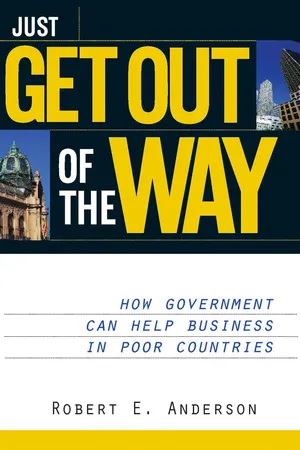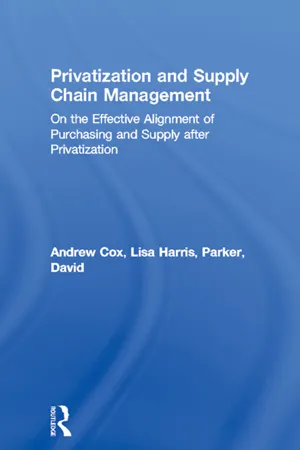Economics
Privatisation of Markets
Privatization of markets refers to the process of transferring ownership and control of state-owned enterprises to private individuals or entities. This often involves the sale of government assets, deregulation, and increased competition. The aim is to improve efficiency, innovation, and investment in the market, but it can also lead to concerns about inequality and loss of public control over essential services.
Written by Perlego with AI-assistance
Related key terms
12 Key excerpts on "Privatisation of Markets"
- eBook - ePub
Road Freight and Privatisation
The Case of Egypt
- Nabil Abdel-Fattah, Richard Gray, Sharon Cullinane(Authors)
- 2019(Publication Date)
- Routledge(Publisher)
The definition of privatisation as the legal transfer or sale of state-owned or collectively-owned physical and financial assets to private owners may be neither sufficiently comprehensive nor precise (Andreff, 1992). Privatisation may sometimes come about without the transfer or sale of state or collective assets, since the share of private businesses in the economy may increase when new and already established private enterprises grow faster than enterprises in the non-private sector of the economy. Privatisation also implies that new private owners acquire three decisive rights over assets; namely, to utilise assets, to appropriate any returns from them, and to transfer assets and dispose of property. Owners who cannot enforce all these rights enjoy only ‘alleviated economic property’.Letwin (1988) sums up the objectives of privatisation as the following: to reduce the burdens of the exchequer and the state’s budget deficit; to consolidate the social and political grip of capitalism by building up popular capitalism; to make the economy more competitive; to reduce the interference of politics in the working of commerce; to bring workers into widespread share ownership; and to speed up the development of the capital market. Other writers also claim similar objectives associated with economic efficiency and reducing the government’s financial deficit (Stevens, 1992; Grosfeld, 1991; Lieberman, 1994).Many definitions of privatisation in essence state that it is a process of denationalisation and transference of state-owned assets or state-controlled activities to the private sector, leading to a change in the proportion of shares of both state and private sectors in the national economy (Pirie, 198S; Kay and Thompson, 1986; Shackleton, 1984; Haritos, 1987; Dodgson and Topham, 1988).Privatisation in economies in transition
Particular features associated with developing countries or transitional economies need to be considered when defining privatisation. Clague and Rausser (1992) state that the term ‘privatisation’ has come to be applied both to the sale of state enterprises to private shareholders in Western economies and to the wholesale transformation of the state enterprise sector in East- Central Europe into private ownership. Although the two situations may share common features, the underlying impact may be substantially different. The former involves transferring the ownership of shares from the government to private hands in an already existing market economy, whereas the latter involves changing the rules of the game for all participants, or creating entirely new institutions suitable for a market economy. - Michael Tribe(Author)
- 2020(Publication Date)
- Routledge(Publisher)
3 Privatisation in developing countries An evolving relationship between state and markets Colin KirkpatrickIntroduction
‘Privatisation’ is generally used to refer to the transfer of a business, industry or service from public to private ownership and control. While there is uncertainty about who first coined the term, the adoption of privatisation as a strategic policy objective is unambiguously linked to the UK Conservative government led by Prime Minister Margaret Thatcher.1 The years from 1979 to 1997 saw a large movement of assets in Britain from state to private ownership using a range of privatisation measures including public flotations and trade sales of nationalised industries, divestments and assets sales, and competitive tendering and contracting out of public services and by June 1987 ‘the programme of privatization was a central plank of government economic policy’ (Parker, 2009: 140). In 1988, the Chancellor of the Exchequer, Nigel Lawson, commented that while the techniques and methods of privatisation had changed during the 1980s to reflect the different types of businesses, the objective had remained the same, namely ‘to improve industry’s efficiency and its service to the customer’.2While the Conservative government under Mrs Thatcher’s leadership can claim to have pioneered the concept of privatisation as a policy instrument, the term ‘privatisation’ quickly became part of the public lexicon with privatisation policy being actively pursued throughout the developed and developing worlds.The intellectual principles of economic neoliberalism are discussed at length elsewhere in the volume, particularly in the first two chapters in this collection, by Michael Tribe and Bernard Walters. Here, we use the term ‘economic neoliberalism’ to refer to the fundamental idea that ‘markets matter’ for achieving economic efficiency and economic growth, with the important caveat that markets can only operate efficiently under certain ‘conditions’ that can be affected (positively and negatively) by government or societal intervention.3- eBook - ePub
Economics of Institutional Change
Central and Eastern Europe Revisited
- Elodie Douarin, Tomasz Mickiewicz(Authors)
- 2017(Publication Date)
- Palgrave Macmillan(Publisher)
They were thus forced to lease property. The fundamental problem in both cases was an inefficient or under-developed capital market. The market value of any asset is determined by the expected future net income flow, and the ratio of the value of capital to all production generated in the economy (GDP) is typically estimated by the capital markets at somewhere near or above 3:1. Nevertheless, any attempt at a one-off sale of the majority of those assets leads immediately to a liquidity problem. Demand for assets is insufficient, and the prices in privatisation sales become depressed to such a degree that the privatisation effectively amounts to the free transfer of a vast amount of wealth to a selected group of economic owners. This is risky from the political point of view, as such method of wealth redistribution it is likely to run against any socially accepted principles of justice, undermining not only the credibility of the government, but possibly, even the legitimacy of the whole new economic system. Slower privatisation is an alternative. However, slow privatisation would mean that the behaviour of enterprises might remain inconsistent with the market environment created by liberalisation, and reforms might not produce positive results (e.g. da Rocha 2015). 2 Privatisation Objectives: Efficiency, Finance and Political Economy With these elements in mind, it should be clear that privatisation is more than just an economic policy. A massive transfer of assets is involved and the character of the resulting ownership structures has implications not only for the distribution of wealth but also for the shape of the political structure and of the civil society - INTERNATIONAL MONETARY FUND(Author)
- 1989(Publication Date)
- INTERNATIONAL MONETARY FUND(Publisher)
The recent worldwide trend—although possibly having its origins in a shift toward more private enterprise-oriented government—seems to be based now on a growing consensus of conservatives and liberals alike that private sector management and competition in the marketplace make for greater economic efficiency and social well-being than does significant state control over, and ownership of, enterprises. That many socialist countries are also moving in varying degrees toward privatization of management or ownership speaks to this point.Before going further, it is important to note that privatization, in the current usage of the term, relates mainly to the transfer of ownership from the state to the private sector. An important consideration, however, is whether privatization includes the transfer of control over the relevant business inputs and outputs and of operational management as well. This consideration is important because the main benefits of privatization relate to efficiency factors which can be achieved only if management is reasonably independent of state control. It follows that privatization of ownership alone can have little effect on enterprise efficiency and on economic growth in general. In fact, if the only change is one of nominal ownership, the only likely benefit is a marginal one-time increase in public revenues and a balancing reduction in private savings.That said, the purpose of this paper is to outline the special interrelationships of efforts toward privatization and financial market—especially equity market—development. The objective is to demonstrate that without a strong and efficient domestic financial market, privatization of ownership—let alone of control and management—is difficult to accomplish, and the ultimate goals—enhancing economic efficiency and social well-being—are impractical targets. Thus, for those who appreciate the importance of developing financial markets, privatization programs present a major opportunity to institute the economic and financial “liberalization” measures and equity market reforms necessary to succeed in both efforts.This paper will provide some country comparisons to trace how privatization programs have contributed to financial market efficiency and economic growth in selected countries. It will conclude with some comments on how these other experiences may be relevant to the further development of financial markets in Arab countries and why such development (especially of their equity markets) should lead to, or at least proceed in tandem with, privatization. The tables (provided by the International Finance Corporation) give an indication of how various countries compare with respect to the factors related to privatization and the development of equity markets that help make privatization successful.- eBook - ePub
The Impact of Privatization
Ownership and Corporate Performance in the United Kingdom
- Stephen Martin, David Parker(Authors)
- 1997(Publication Date)
- Routledge(Publisher)
1 PRIVATISATION
The conceptual framework
INTRODUCTION
In the last decade many countries have introduced privatisation programmes. In 1995 the value of state selloffs is reported to have reached a record figure of US$73bn with at least forty-five countries in the process of privatising some industries (Economist, 13 January 1996, p. 5). This figure may exaggerate the degree of true privatisation since some governments choose to describe the sale to the private sector of only a small part of the total shareholding as a privatisation. Nevertheless, there can be no doubting the profound effect of world-wide privatisation on industrial organisation both in the developed and the developing world.Table 1.1 UK privatisation proceedsThis book is concerned with privatisation in the UK where, since 1979, over £60bn of UK business assets have been transferred from the state sector to the private sector. At first the annual value of sales was low but, as reflected in the figures in Table 1.1 , since the mid-1980s sales have regularly exceeded £5bn per annum, reaching a figure of over £8bn in 1992–3. Table 1.2 provides a summary listing of the main industrial privatisations since 1979 in the UK. Whole industries, such as water, electricity and gas supply, have been affected, along with large sections of the transport, aerospace and telecommunications industries. Because of the size and scope of the privatisation programme, the UK is an obvious candidate for studying the economic effects of this policy. Also, sufficient time has now passed since the early privatisations to begin to assess their longer-term economic impact.Table 1.2 Major privatisations in the UKIn the UK, as in many other countries, the political pressure for privatisation came from a combination of disillusionment with the results of state ownership and from a belief that private ownership would bring substantial economic benefits. State-owned industries were viewed as highly inefficient, slow at developing and introducing new technologies, subject to over-frequent and damaging political intervention and dominated by powerful trade unions (Veljanovski, 1987). Privatisation seemed to offer a means of ridding the state of the financial burden of loss-making activities, while at the same time spreading share ownership and curtailing union power (Arbomeit, 1986). Moreover, privatisation sales offered a tempting source of state funding at a time when economic policy was geared to reducing the public sector borrowing requirement (PSBR). - eBook - ePub
Just Get Out of the Way
How Government Can Help Business in Poor Countries
- Robert E. Anderson(Author)
- 2004(Publication Date)
- Cato Institute(Publisher)
4. Privatization: Just Sell It
A central element of any program to develop the private sector is that the government should transfer commercial activities now carried out by state-owned enterprises or government agencies to the private sector. Since the early 1980s, many poor countries have privatized state-owned enterprises, in other words, transferred ownership to private investors. There is widespread agreement that stateowned enterprises have performed badly and that privatized companies have usually performed better. I will not attempt to summarize the hundred or more studies that provide empirical data that demonstrate this conclusion.1 Few now argue, at least publicly, that privatization is a poor policy.Given this acceptance of the need to privatize state-owned enterprises, one would expect that there is widespread agreement on both the objectives of privatization and the methods of privatization that best achieves those objectives. Instead, the voluminous literature on privatization contains a bewildering list of objectives. Similarly, numerous methods or techniques of privatization have been used, including trade sales, initial public offerings, management-employee buyouts, voucher privatization, and capitalizing pension funds.In contrast to most other issues in economic development, international development agencies, consultants, and academics do not seem to have reached a consensus on what the objectives of privatization ought to be and what methods will best achieve those objectives. The prevailing view seems to be that each country is unique and the objectives and methods of privatization need to be tailored to the specific circumstances of each country.The following is typical of what is written about privatization: ‘‘Privatization is neither a simple or a uniform process. Starting points differ; countries have varying objectives, face a wide and shifting range of problems and obstacles, and thus need to adopt different strategies and tactics to achieve their privatization objectives. There is no universally applicable approach to privatization, and the attempt to apply a ‘one size fits all’ has proved ineffective and counterproductive.’’2 - eBook - ePub
Privatization of Public Services
Impacts for Employment, Working Conditions, and Service Quality in Europe
- Christoph Hermann, Jörg Flecker(Authors)
- 2013(Publication Date)
- Routledge(Publisher)
1 Since liberalisation is an ongoing process, even in those sectors that are fully liberalised the findings can only present a snapshot. The focus of the analysis presented in this chapter (and throughout the book) is the period from the mid-1990s to the mid-2000s. The chapter starts with a clarification of important terminology associated with the liberalisation processes. The next section summarises major steps in the liberalisation process in the sectors and countries under investigation and compares sectors and countries. This is followed by an evaluation of the effects in terms of market and ownership structures, since a major claim of privatisation advocates is that competitive markets and private ownership will improve service provision (Asquer 2010, 86; Savas 2000). The next section, then, summarises major changes in regulation introduced in connection with liberalisation, privatisation and marketisation. The chapter ends with a brief discussion of the findings.THE CONCEPTS OF LIBERALISATION, PRIVATISATION AND MARKETISATIONThe terms liberalisation, privatisation and marketisation are often used to describe the profound transformation of public services in the last two decades, from the abolishment of public sector monopolies to the sale of public assets and the introduction of new, performance-based funding schemes, and sometimes even the introduction of New Public Management (NPM) techniques. The wide use of these terms has the potential to obscure some causes and effects of the restructuring of public services. We therefore want to start this chapter by clarifying some terminology.Liberalisation essentially means the abolishment of public sector monopolies and the creation of public service markets with at least two providers competing for customers (Coen and Doyle 2000). Consumers in return receive the option of choosing between at least two different operators. Liberalisation ultimately aims at establishing perfectly competitive market structures, with many providers which have no market dominance. Oligopolistic markets, where a few providers have market dominance, ought to be avoided. Liberalisation - eBook - ePub
- Andrew Cox, Lisa Harris, David Parker(Authors)
- 2005(Publication Date)
- Routledge(Publisher)
17 The following chapters are concerned with advancing knowledge by reporting the results of a questionnaire survey of purchasing, supply and procurement managers in a cross-section of UK privatised companies and follow-up interviews. The objective is to assess to what extent and in what ways purchasing and supply practices have changed, and are changing, as a consequence of privatisation and how these might be impacting on performance.Privatisation is an important part of industrial policy in a large number of countries worldwide. The policy has been promoted because of expected efficiency gains when enterprises are transferred from the public to the private sector. At the same time, however, research has suggested that organisational restructuring within the privatised firms may be critical in determining the outcome, although the precise nature of the restructuring still requires investigation. In particular, there has been no systematic study of privatisation and purchasing and supply practices.Corporate strategy is contingent upon the external environment faced by the firm after privatisation, changes in that environment and the precise management response. Privatisation in the UK has led to a considerable shrinking of the state sector, but some enterprises seem to have taken more advantage than others of the opportunities created. These enterprises seem to be, not surprisingly, the ones that have improved their performance most noticeably. The research which forms the basis of the content of this book sets out to address a number of related issues concerned with purchasing and supply strategies in privatised companies. The main issues are: - eBook - ePub
The Market Revolution and its Limits
A Price for Everything
- Alan Shipman(Author)
- 2002(Publication Date)
- Routledge(Publisher)
Whereas the government’s generally lower cost of capital and (hence) longer time horizons had been an argument for its taking responsibility for strategic industrial and infrastructure investment, whether or not external benefits were involved, the perception of government as an inherently less efficient producer switched the priority to improving the long-term capital supply to private enterprise. The first step that governments could take, it seemed, was to stop ‘crowding out’ private investment through its own calls on the capital market. The second was to end the subsidy, cheap capital and political privileges of public enterprise, so that private firms could compete with it on more equal terms. Much the easiest way, where the size of capital markets and potential acquirers allowed, was to let the private sector take over the state firm.Natural monopoly presented more of a problem. Where domestic competitors need time to develop, or are kept out by the former state monopoly’s scale-economies and sunk investments acting as entry barrier, competition has generally needed to be substituted by regulation, exchanging one intervention in the market fo another. Over time, therefore, enthusiasm has grown for following privatisation with moves to generate additional product-market competition— internally by break-up of the former state monopoly (horizontally into rival suppliers and distributors interconnected to the natural-monopoly network, and/ or vertically into competing integrated producers), or externally by opening the market to international competition (including that from other countries’ national champions and natural monopolies).Privatisation has achieved some spectacular successes—notably in telecommunications, where technical change has significantly reduced natural-monopoly elements—and some notable failures, with the UK still struggling with higher charges, substandard quality and frequent shortages of water seven years after floating the industry. But aside from the faith that greater efficiency will eventually win through, another more immediate advantage of privatisation has become apparent: the large sums of money that can be raised from selling assets into a rising stock-market, which can be used either to reinvest in the industry, to repay public debt, to invest in other more appropriate public assets (infrastructure, education) or—with rather less respect for ‘golden-rule’ preservation of public-sector net worth, but a possibly beneficial effect on private investment—to finance tax reduction. - INTERNATIONAL MONETARY FUND(Author)
- 1991(Publication Date)
- INTERNATIONAL MONETARY FUND(Publisher)
The intention in Poland, for example, is to privatize about a half of state industry, which dominates the economy, in as little as three years. While the political commitment to privatization as a means of effecting the transformation from a planned to a market economy is not in doubt, the institutional obstacles are immense. There are no capital markets, adminsitrative capacity is weak, the legal infrastructure hardly recognizes private property, price distortions make valuation difficult, and domestic savings are a small fraction of enterprise worth. To resolve the conflict between bold ambition and weak implementation capacity, a combination of every available privatization technique is being adopted, including mass privatization based upon the free disposal of shares to the population. At the same time, privatization is being supported by wide-ranging price and trade liberalization, appropriate competition policy, and fiscal and monetary reform. Fiscal Impact of Privatization Privatization is often ascribed objectives that extend beyond efficiency improvements. Diluting the strength of public sector trade unions and achieving wider share ownership are sometimes mentioned. However, it is in connection with reducing public sector deficits that privatization is most frequently associated. This is especially so where the sale of public sector assets, mainly public enterprises, is concerned. Privatization and fiscal stance As recommended in the Fund’s Manual on Government Finance Statistics, proceeds from enterprise sales are treated as capital revenue or a loan repayment in the government accounts, which will lead to a once-and-for-all reduction in the fiscal deficit, assuming that the sale price obtained is greater than the net income generated for the government by the enterprise in the year of the sale. The change in the deficit, however, may not necessarily reflect a fundamental change in the fiscal policy stance- eBook - ePub
The Productive Efficiency of Container Terminals
An Application to Korea and the UK
- Dong-Wook Song, Kevin Cullinane, Michael Roe(Authors)
- 2017(Publication Date)
- Routledge(Publisher)
In respect of private ownership, the threats of takeover and bankruptcy become obviously crucial to management since these generate incentives for managers to act in the interests of owners. By purchasing shares on the market, an individual or firm can quickly concentrate ownership and wrest control of the target company from its incumbent management. This possibility gives rise to a potentially powerful incentive effect. If the performance of a management is poor then the share price of the firm will drop and the returns from a takeover raid designed to introduce a new management will increase. The threat of replacement, as a consequence, serves as a disciplining factor on incumbent managements. Unfortunately, however, there are strong grounds for believing that the market for company control exhibits a number of significant imperfections. The marketability of property rights does not correct the market failure arising from dispersed shareholdings. For instance, a small shareholder can neglect the consequences of his or her selling and holding decision on the outcome of a takeover, and, if the bid is expected to succeed, will prefer to hold in order to take part in the profit gains accruing from the change in control. If enough shareholders behave in this way, the takeover will fail. Singh (1975) conducted extensive empirical research to find the relationship between company performance and takeover, and found evidence that the threat of involuntary takeover is not strongly related to a given management's relative profit performance.In summary, private enterprises may be subject to a variety of capital market pressures not faced by public counterparts, and these pressures will, in turn, be dependent on the nature of the financial institutions in the economy. The privatisation of industrial enterprises might mean very little, therefore, if the government continued to dominate the economy's financial system (Jasinski and Yarrow, 1996). In countries which do not have a sophisticated stock market and banking system, one of the objectives of privatisation may be to strengthen private capital market institutions. What is crucial, on the other hand, is a case-by-case approach to the incentive problem that allows for some quantification of the various factors that are relevant to the principal-agent relationships.Public Ownership and Incentives
According to the argument of Stiglitz (1988), the main difference between public and private enterprises is concerned with incentives, both organisational and individual. In terms of the organisational incentives, public enterprises differ from private enterprises in two important ways: (i) they do not need to worry about bankruptcy, and (ii) they usually do not have to worry about competition. In terms of individuai incentives, on the other hand, the differences come from the incentive structures facing government employees, that is, (i) managers in public enterprises seldom have pay structures that are as closely related to profit as managers in private ones, (ii) it is generally very difficult to fire government employees, and this attribute of security is often cited by potential employees as one of the more desirable features of government employment. - eBook - ePub
The Official History of Privatisation Vol. I
The formative years 1970-1987
- David Parker(Author)
- 2009(Publication Date)
- Routledge(Publisher)
During the early 1980s in Britain a new orthodoxy developed in favour of private ownership replacing state ownership. This was a product of repeated government wrestling with the challenges of running large sectors of the economy efficiently and effectively and at a time of macroeconomic turbulence brought on, not least, by a sharp rise in energy prices. But the new orthodoxy was also consistent and in tune with a movement in economics away from state planning, Keynesianism and the concept of a “welfare state” towards market liberalisation, monetarism and the concept of consumerism during the 1970s. In this the economics of public choice and agency theory played the important role of providing an intellectual rationale for why private ownership should be more efficient than state ownership. This economics came largely from the USA, but was championed in Britain by right-wing think tanks such as the Institute of Economic Affairs and the Adam Smith Institute. Margaret Thatcher and other leading Conservatives had links with these organisations. The ideas also had an influence on Conservative Party thinking through Party organisations, notably the Centre for Policy Studies established by Sir Keith Joseph in 1974.Privatisation gained an intellectual rationale which offered the prospect of industries being managed more efficiently and effectively. But more pragmatically, privatisation provided the new Conservative Government with the means of closing the yawning gap between public spending and tax revenues. What really kick-started the privatisation programme after May 1979 was the demand from Treasury Ministers that state assets should be identified for sale. The search for candidates for disposal within Government after May 1979 was driven principally by budgetary pressures. Privatisation receipts were netted off against public expenditure in the UK’s public finances and therefore had the bonus of appearing to reduce the size of public spending as a proportion of GDP, an outcome consistent with the Government’s macroeconomic agenda. At first the disposals programme mainly took the form of sales of surplus land and buildings and small shareholdings in organisations with some state ownership due to historical accident, such as BP and Suez Finance (the previous Labour Government had already sold some of the state’s shareholding in BP and for the same reason, to raise cash). As Ministers concentrated upon identifying “special asset sales”, as they tended to be termed in the public accounts, this led in time to interest in the possibility of selling entire nationalised industries – and growing confidence that it would be possible. As Thatcher comments, “we got bolder and we learned as we went along.”4
Index pages curate the most relevant extracts from our library of academic textbooks. They’ve been created using an in-house natural language model (NLM), each adding context and meaning to key research topics.











